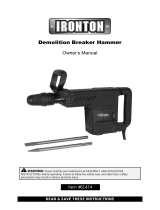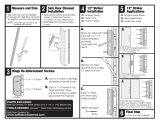--- 12 ---
9. PRECAUTIONS IN DISASSEMBLY AND REASSEMBLY
The [Bold] numbers in the descriptions below correspond to the item numbers in the Parts List and exploded
assembly diagram.
9-1. Disassembly
NOTE: If it is difficult to loosen and remove the fixing bolts, use an appropriate heating device to heat
them to approximately 80 ûC (176 ûF).
(1) Disassembly of the Armature Ass'y [72]
A. Loosen the four Seal Lock Hex. Socket Hd. Bolts M4 x 8 [51], remove the Cap Covers [52], Cap Rubbers [53]
and Brush Caps [54], and take out the Carbon Brushes (Auto Stop Type) (1 Pair) [55]. At this time, be very
careful not to lose the disassembled parts.
B. Loosen the four Nylock Hex. Socket Hd. Bolts M8 x 35 [23], and remove the Cylinder Case [19]. Next, after
loosening the Seal Lock Hex. Socket Hd. Bolt M8 x 16 [31], the Connecting Rod Ass'y [28] and Crank Washer
[30] can be disassembled. Leave the Striker [21] and the Piston [27] as they are.
C. Remove the four Seal Lock Hex. Socket Hd. Bolts M5 x 16 [60] and three Tapping Screws (W/Flange) D4 x 25
(Black) [93]. Remove Handle (A) [82], Handle (B) [84], four Nylock Bolts (W/Flange) M5 x 12 [102] and Back
Cover [79]. Remove the six Seal Lock Hex. Socket Hd. Bolts M6 x 45 [57], Gear Cover [35] and Counter
Gear [62]. Insert a flat-blade screwdriver or a similar tool into the air vent of the Inner Cover [39] and raise the
Inner Cover [39]. Then the Inner Cover [39], Armature Ass'y [72] and Crank Shaft [44] can be removed as a
single unit. At this time, be very careful not to damage the Fan [71].
D. As illustrated in Fig. 13, support the Inner Cover [39] with an appropriate tubular jig, and push down on the end
surface of the armature shaft with a hand press to separate the Armature Ass'y [72] from the Inner Cover [39].
Fig. 13
(2) Disassembly of the Crank Shaft [44] section
First, remove the four Seal Lock Hex. Socket Hd. Bolts M5 x 16 [43] which fix the Bearing Cover [42]. Then,
as illustrated in Fig. 14, support the lower surface of the Inner Cover [39] with an appropriate tubular jig, align
an appropriate steel rod with the end surface of the Crank Shaft [44], and press down on the steel rod with a
hand press. The Ball Bearing 6205DDCMPS2L [41], Distance Ring (B) [38], Final Gear [37], two Woodruff
Keys 4 x 16 [68], and Crank Shaft [44] can then be disassembled from the Inner Cover [39].
Inner Cover [39]
Crank Shaft [44]
Armature Ass'y [72]
Press the end surface of the
armature with a hand press.
Tubular jig






















